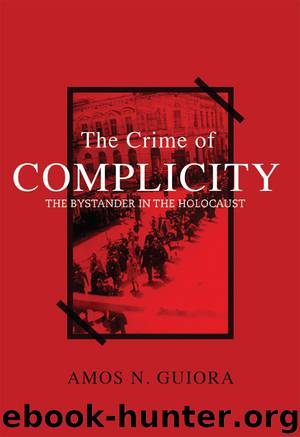The Crime of Complicity by Amos N. Guiora

Author:Amos N. Guiora
Language: eng
Format: epub
Publisher: American Bar Association
Published: 2017-06-26T16:00:00+00:00
The Crime of Complicity
Implementation of the Final Solution—the deliberate, conscious decision to eradicate European Jewry—required something else. That extra, for lack of a better term, was the complicity of millions throughout Europe. While the Third Reich created policy, its implementation was dependent on two additional actors—perpetrators and bystanders.
The perpetrators are too numerous to count—Lithuanians who shot Jews, Latvians who forced Jews to dig their own graves, Ukrainians who brutalized Jews, Germans who gassed Jews in concentration camps, Polish train conductors who transported Jews to Auschwitz, Dutch policemen who rounded up Jews, Hungarian Arrow Cross who murdered Jews, and French authorities who collaborated with the German occupation.
As long and reprehensible as that list is—and it is but a sample of European perpetrators—it does not fully explain the murder of 6 million Jews. To fully understand the Final Solution requires us to recognize the complicity of the bystander. To what extent Heydrich assumed bystander complicity when establishing the Final Solution is unclear; what is clear is the degree to which bystander complicity enabled the Final Solution.
That is, perpetrator conduct was the active “engine” that drove the Holocaust, whereas bystander nonintervention was essential to its implementation. That nonintervention is the complicity that enabled perpetrators to fulfill Hitler’s goal of destroying European Jewry. Without their complicity, the Holocaust does not occur on the scale it did; that same refrain is relevant to crimes, whether large or small, committed in the decades after the Holocaust.
For that reason I recommend bystander complicity be understood to be a crime. For some, framing bystander complicity as a “moral code” is comforting and more tolerable than defining it as a crime. Doing so resonates with notions of acting ethically in the face of aggression to another. There is something reassuring in convincing ourselves we “know the right thing to do.”
However, the aspirational model is just that, aspirational. The reality—as uncomfortable as it may be—is that the “doing the right thing” is, largely, illusionary, reflecting empty words. Bystander complicity is more common than bystander intervention; turning the proverbial blind eye far outweighs standing up to violence exercised by another.
History clearly shows that, unfortunately.
Because harm is the direct result of bystander nonintervention, complicity must be perceived as directly contributing to that harm.
The term complicit, in this context, is neither abstract nor philosophical; it is intended from a purely legal perspective with consequences to the actor. The culpable actor is the one who failed to act; the crime committed was nonintervention.
Nonintervention is the essence of complicity. With respect to bystander complicity, the focus is assistance not provided by the bystander to the victim in the face of clear and present danger posed by the perpetrator. The bystander fails to intervene on behalf of a vulnerable individual. That makes the bystander complicit regarding harm that befalls the victim.
However, casting too broad a net is unreasonable and unfeasible. Similarly, unnecessarily limiting application of the proposed bystander definition would fail to achieve my stated goal.
The burden is applying a legally tolerable and practically implementable definition.
Download
This site does not store any files on its server. We only index and link to content provided by other sites. Please contact the content providers to delete copyright contents if any and email us, we'll remove relevant links or contents immediately.
The Borden Murders by Sarah Miller(4025)
The Secret Barrister by The Secret Barrister(3425)
Coroner's Journal by Louis Cataldie(2361)
Police Exams Prep 2018-2019 by Kaplan Test Prep(2361)
The Splendid and the Vile by Erik Larson(2231)
Terrorist Cop by Mordecai Dzikansky & ROBERT SLATER(1965)
My Dark Places by James Ellroy(1806)
A Colony in a Nation by Chris Hayes(1797)
Black Klansman by Ron Stallworth(1705)
The Art of Flight by unknow(1697)
A Life of Crime by Harry Ognall(1597)
Objection! by Nancy Grace(1572)
The New Jim Crow by Michelle Alexander(1552)
Whoever Fights Monsters by Robert K. Ressler(1538)
Anatomy of Injustice by Raymond Bonner(1532)
Invisible Women by Caroline Criado Perez;(1521)
Obsession (The Volkov Mafia Series Book 1) by S.E Foster(1498)
American Prison by Shane Bauer(1481)
A is for Arsenic: The Poisons of Agatha Christie (Bloomsbury Sigma) by Kathryn Harkup(1458)
